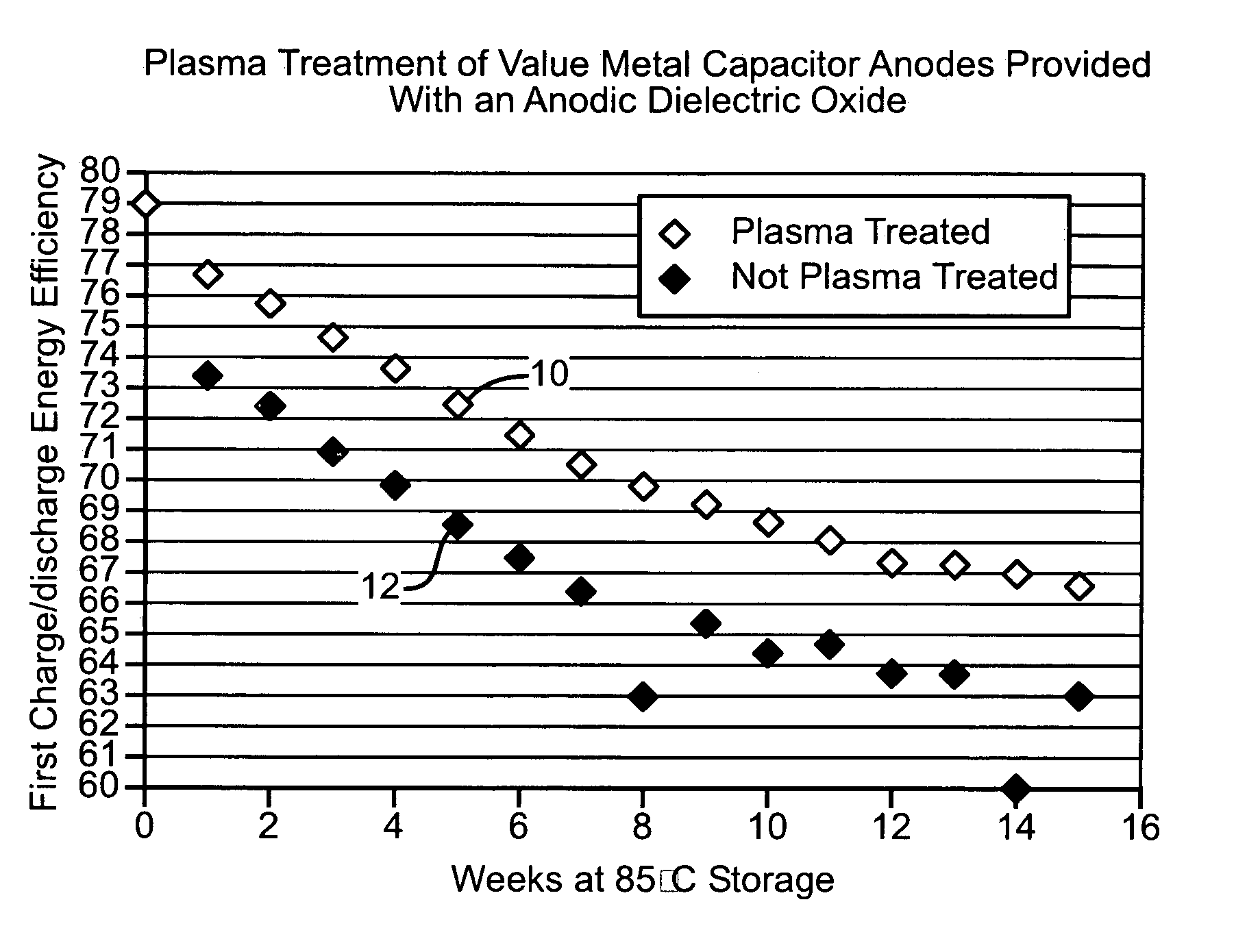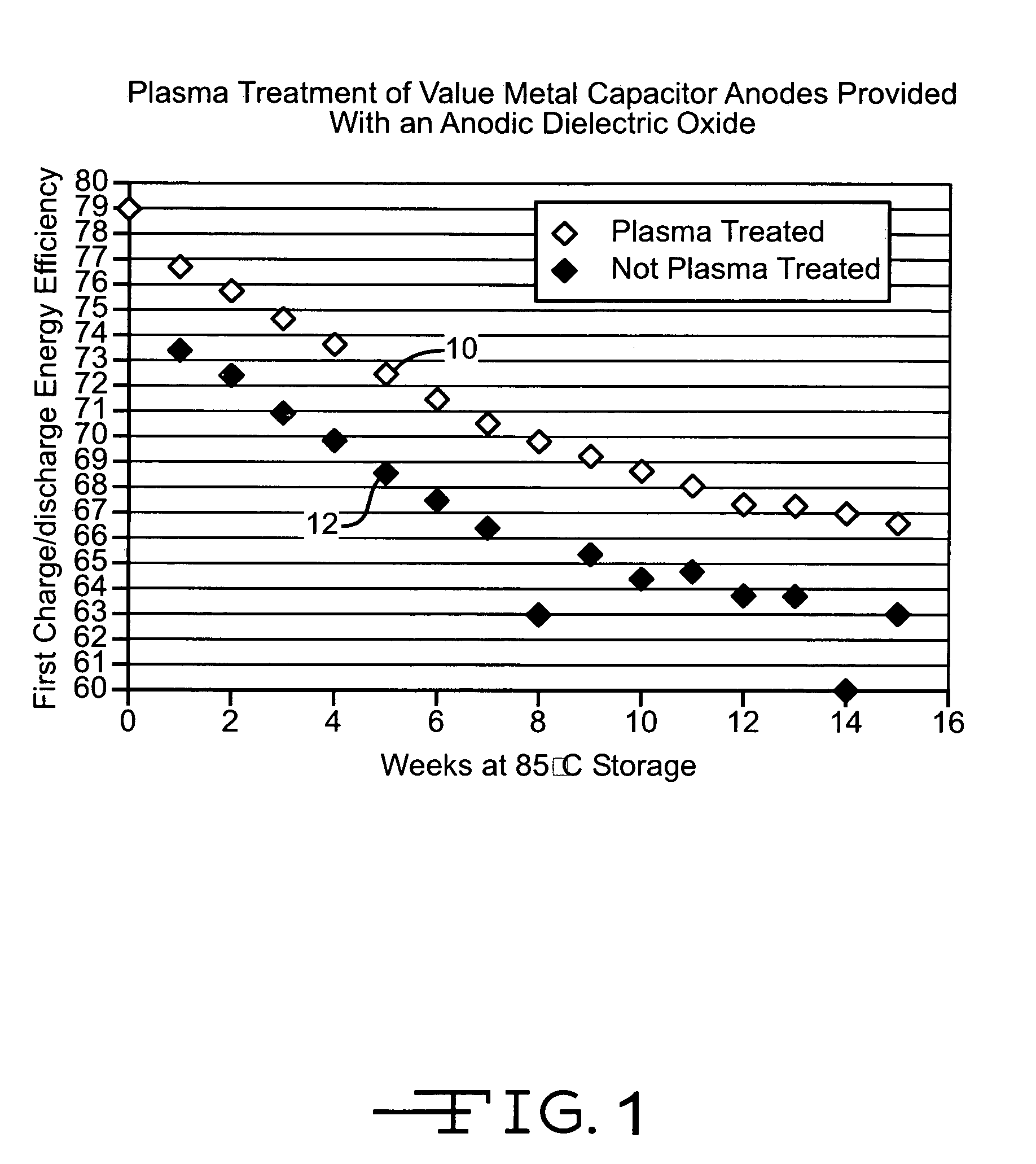Plasma treatment of anodic oxides for electrolytic capacitors
a technology of dielectric oxide and electrolytic capacitor, which is applied in the manufacture of capacitors, capacitor dielectric layers, variable capacitors, etc., can solve the problems of affecting the dc leakage adversely affecting the dc leakage and stability of the oxide layer, and undesirable for a capacitor to experience high dc leakage and oxide degradation, so as to reduce the dc leakage of the capacitor, improve the electrical properties of the dielectric layer, and reduce the d
- Summary
- Abstract
- Description
- Claims
- Application Information
AI Technical Summary
Benefits of technology
Problems solved by technology
Method used
Image
Examples
example i
[0027]A plurality of pressed powder tantalum pellets served as test bodies. They were sintered tantalum powder pellets having an anodically formed tantalum oxide layer about 0.43 μm thick. The pellets are of the type incorporated into tantalum electrolytic capacitors commercially available from Wilson Greatbatch Technologies, Inc., the assignee of this invention.
[0028]Plasma treatment was done in a high-density oxygen plasma chamber. Inductive coupling at 380 kHz RF and 2500 W power supply generated the high-density plasma. The oxygen plasma chamber was maintained at about 0.5 to about 50 mTorr with an ion density of about 1011 ion / cm3 to about 1012 ion / cm3. The anodized tantalum bodies were oxygen plasma treated at various substrate temperatures up to 300° C. with the plasma power ranging from about 500 watts to about 1100 watts. Exposure times ranged from about 1 minute to about 10 minutes. Detailed experimental conditions are shown in Table 1.
[0029]After plasma treatment, the tan...
example ii
[0035]The capacitors used to create Tables 1 and 2 were further subjected to an accelerated life test. This was done by storing them at 85° C. without bias and then performing a charge / discharge test weekly at 37° C. Charging the individual capacitors at a constant current of 10 mA to the rated voltage of 215 V and subsequently discharging them through a load resistor of about 17 ohms provided the average charge / discharge energy efficiency values shown in FIG. 1. The charge / discharge energy efficiency is the total energy delivered during discharging divided by the total energy put in during charging. The treated anodes were those subjected to O2 plasma having an ion density of about 1011 ion / cm3 to about 1012 ions / cm3 at 500 watts, 203° C. for 4 minutes. This accelerated life test is typically used in evaluating capacitors for implantable cardioverter defibrillators The curve labeled 10 in FIG. 1 was constructed from the capacitors containing the plasma treated anodes while the curv...
PUM
| Property | Measurement | Unit |
|---|---|---|
| power | aaaaa | aaaaa |
| thick | aaaaa | aaaaa |
| temperature | aaaaa | aaaaa |
Abstract
Description
Claims
Application Information
 Login to View More
Login to View More - R&D
- Intellectual Property
- Life Sciences
- Materials
- Tech Scout
- Unparalleled Data Quality
- Higher Quality Content
- 60% Fewer Hallucinations
Browse by: Latest US Patents, China's latest patents, Technical Efficacy Thesaurus, Application Domain, Technology Topic, Popular Technical Reports.
© 2025 PatSnap. All rights reserved.Legal|Privacy policy|Modern Slavery Act Transparency Statement|Sitemap|About US| Contact US: help@patsnap.com


